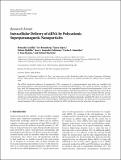Intracellular Delivery of siRNA by Polycationic Superparamagnetic Nanoparticles
Author(s)
Castillo, Betzaida; Badillo, Valerie; Hatton, T. Alan; Barletta, Gabriel; Bromberg, Lev E.; Lopez, Xaira; Gonzalez Feliciano, Jose A.; Gonzalez, Carlos I.; ... Show more Show less
DownloadJDD.2012.218940.pdf (1.389Mb)
PUBLISHER_CC
Publisher with Creative Commons License
Creative Commons Attribution
Terms of use
Metadata
Show full item recordAbstract
The siRNA transfection efficiency of nanoparticles (NPs), composed of a superparamagnetic iron oxide core modified with polycationic polymers (poly(hexamethylene biguanide) or branched polyethyleneimine), were studied in CHO-K1 and HeLa cell lines. Both NPs demonstrated to be good siRNA transfection vehicles, but unmodified branched polyethyleneimine (25 kD) was superior on both cell lines. However, application of an external magnetic field during transfection (magnetofection) increased the efficiency of the superparamagnetic NPs. Furthermore, our results reveal that these NPs are less toxic towards CHO-K1 cell lines than the unmodified polycationic-branched polyethyleneimine (PEI). In general, the external magnetic field did not alter the cell’s viability nor it disrupted the cell membranes, except for the poly(hexamethylene biguanide)-modified NP, where it was observed that in CHO-K1 cells application of the external magnetic field promoted membrane damage. This paper presents new polycationic superparamagnetic NPs as promising transfection vehicles for siRNA and demonstrates the advantages of magnetofection.
Date issued
2012Department
Massachusetts Institute of Technology. Department of Chemical EngineeringJournal
Journal of Drug Delivery
Publisher
Hindawi Publishing Corporation
Citation
Castillo, Betzaida, Lev Bromberg, Xaira López, et al. Intracellular Delivery of siRNA by Polycationic Superparamagnetic Nanoparticles. Journal of Drug Delivery 2012: 1–12. 2012.
Version: Final published version
ISSN
2090-3014
2090-3022